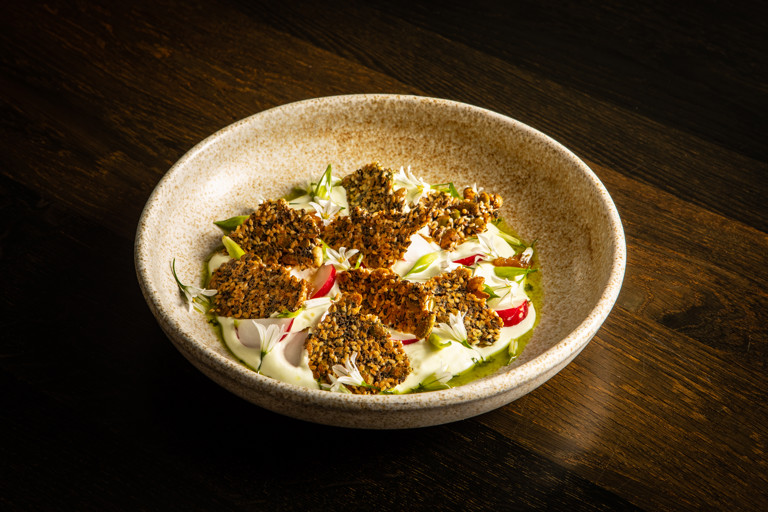Woodruff (galium odoratum) yoghurt, dressing and seeded crackers
Harriet Mansell recommends serving this dip with aperitifs or as part of a sharing menu. She finished her dish with three cornered leek (allium triquetrum) flowers because they were in season, but says you could also use wild garlic (allium ursinum) or chive flowers.
Harvesting woodruff safely requires specialist knowledge, as it can easily become toxic to consume – however, this recipe works just as well with chervil or tarragon, so we recommend using those instead if you don't have experience foraging for woodruff.
Harriet Mansell explains: 'Woodruff has to be handled correctly in order to prevent toxicity. Woodruff contains a compound called coumarin. Because certain moulds could convert the coumarin into dicumarol, it's essential to dry it out fully in a dehydrator or low temperature oven, and then store it in an airtight container. To prevent the conversion, you have to dry the woodruff quickly after washing, and not let it dry slowly.'
'As with all active wild foods, you should take care to note if you have any adverse reactions, and then not eat any more. Woodruff is broadly considered a beautiful fragrant herb and is used relatively widely in food and drinks. However, plants can hybridise and/or take on unfavourable elements from their environment from time to time, and so you should always exercise caution.'
'An alternative to using woodruff in this recipe would be to use some soft aromatic herbs of your liking, such as tarragon or chervil.'
Ingredients
Metric
Imperial
- 12 radishes, quartered
- chive flowers, or wild garlic or three cornered leek flowers
Woodruff oil
- 300ml of pomace oil
- 16g of dried woodruff, or tarragon or chervil
- 5g of flaky sea salt
Woodruff yoghurt
- 500ml of thick yoghurt
- 1 pinch of salt
Mixed seed and seaweed crackers
- 100g of mixed seeds
- 100ml of egg white
- 20g of mixed seaweed flakes
- flaky sea salt, to taste
Woodruff and mint dressing
- 12 mint leaves, about 3g
- 15g of lemon juice
- 5g of salt
Method
For the woodruff oil, blitz all the ingredients in a high-powdered blender at full speed for 30 seconds
- 300ml of pomace oil
- 16g of dried woodruff, or tarragon or chervil
- 5g of flaky sea salt
Heat the mixture to 82°C, then give it a final blitz using a stick blender at full speed
Strain the oil from the solids and cool immediately. Set aside in the fridge until needed
For the woodruff yoghurt, mix all the ingredients together with 120ml woodruff oil, using a spatula or whisk to make sure it is combined evenly
- 500ml of thick yoghurt
- 1 pinch of salt
Preheat the oven to 160°C
Mix all the ingredients for the seed and seaweed crackers, and spread thinly (as thinly as possible) on a lined baking tray. Sprinkle with crushed sea salt flakes
- 100g of mixed seeds
- 100ml of egg white
- 20g of mixed seaweed flakes
- flaky sea salt, to taste
Bake for 15–20 minutes or until toasted nicely
Just before serving, make the dressing. Very finely chop the mint, and run through 75g woodruff oil with the lemon juice and salt
- 12 mint leaves, about 3g
- 15g of lemon juice
- 5g of salt
To serve, spoon the woodruff yoghurt into a bowl. Drizzle around the mint and woodruff dressing and scatter over the quartered radishes and flowers. Break the cracker sheets into shards and prop these up in the yoghurt
- 12 radishes, quartered
- chive flowers, or wild garlic or three cornered leek flowers
Get in touch
Please sign in or register to send a comment to Great British Chefs.


